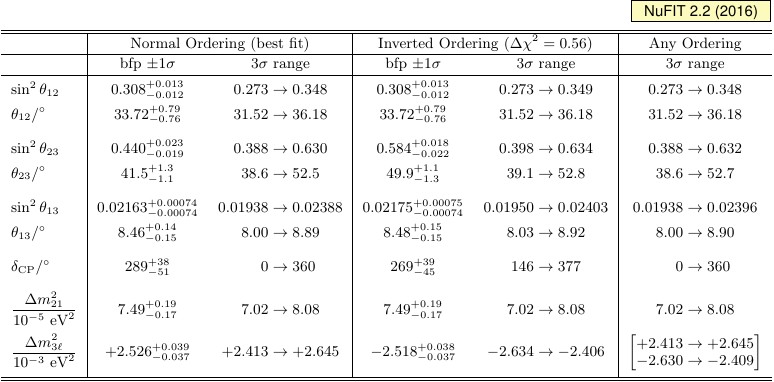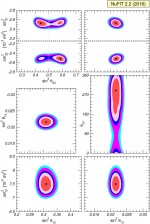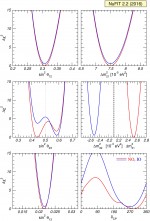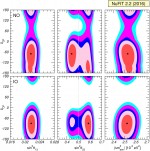
v2.2: Three-neutrino fit based on data available in August 2016
Menu
If you are using these results please refer to JHEP 11 (2014) 052 [arXiv:1409.5439] as well as NuFIT 2.2 (2016), www.nu-fit.org.

|
| Three-flavor oscillation parameters from our fit to global data as of August 2016. The normalization of reactor fluxes is left free and data from short-baseline reactor experiments are included. The numbers in the 1st (2nd) column are obtained assuming NO (IO), i.e., relative to the respective local minimum, whereas in the 3rd column we minimize also with respect to the ordering. Note that Δm23ℓ = Δm231 > 0 for NO and Δm23ℓ = Δm232 < 0 for IO. |

|
| 3σ CL ranges of the magnitude of the elements of the three-flavor leptonic mixing matrix under the assumption of the matrix U being unitary. The normalization of reactor fluxes is left free and data from short-baseline reactor experiments are included. The ranges in the different entries of the matrix are correlated due to the fact that, in general, the result of a given experiment restricts a combination of several entries of the matrix, as well as to the constraints imposed by unitarity. As a consequence choosing a specific value for one element further restricts the range of the others. |
Two-dimensional allowed regions

pdf jpg |
Global 3ν oscillation analysis. Each panel shows the two-dimensional projection of the allowed six-dimensional region after marginalization with respect to the undisplayed parameters. The different contours correspond to the two-dimensional allowed regions at 1σ, 90%, 2σ, 99%, 3σ CL (2 dof). The normalization of reactor fluxes is left free and data from short-baseline reactor experiments are included. Note that as atmospheric mass-squared splitting we use Δm231 for NO and Δm232 for IO. The regions in the lower 4 panels are based on a Δχ2 minimized with respect to the mass ordering. |
One-dimensional χ2 projections

pdf jpg |
Global 3ν oscillation analysis. The red (blue) curves are for Normal (Inverted) Ordering. The normalization of reactor fluxes is left free and data from short-baseline reactor experiments are included. Note that as atmospheric mass-squared splitting we use Δm231 for NO and Δm232 for IO. |
CP-violation: unitarity triangles

pdf jpg |
The six leptonic unitarity triangles. After scaling and rotating each triangle so that two of its vertices always coincide with (0,0) and (1,0), we plot the 1σ, 90%, 2σ, 99%, 3σ CL (2 dof) allowed regions of the third vertex. The contours for Normal (right) and Inverted (left) ordering are defined with respect to the common global minimum. The normalization of reactor fluxes is left free and data from short-baseline reactor experiments are included. Note that in the construction of the triangles the unitarity of the U matrix is always explicitly imposed. |
Correlation between δCP and other parameters

pdf jpg |
Allowed regions from the global data at 1σ, 90%, 2σ, 99%, 3σ CL (2 dof) after minimizing with respect to all undisplayed parameters. The normalization of reactor fluxes is left free and data from short-baseline reactor experiments are included. The upper (lower) panel corresponds to IO (NO). Note that as atmospheric mass-squared splitting we use Δm231 for NO and Δm232 for IO. |
»